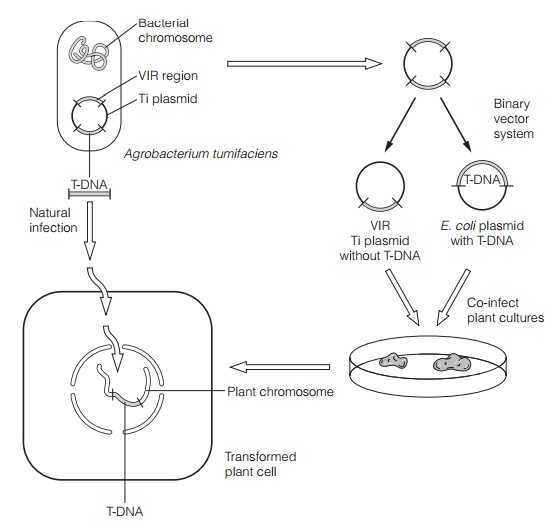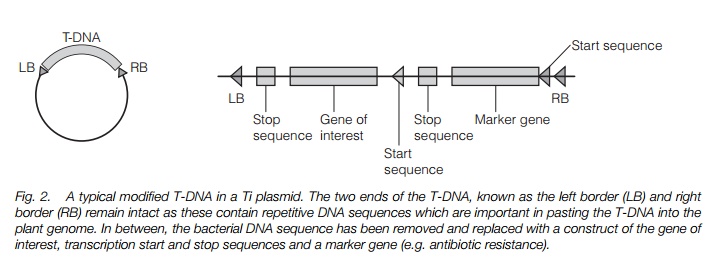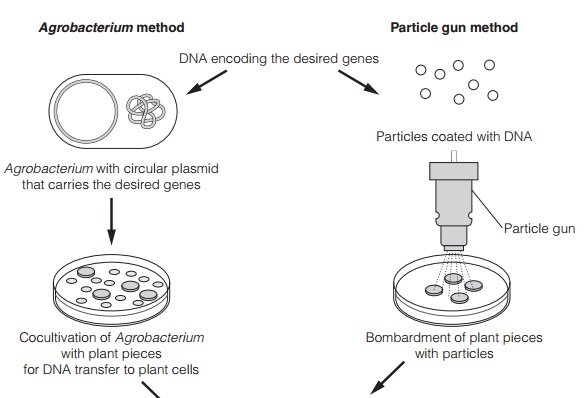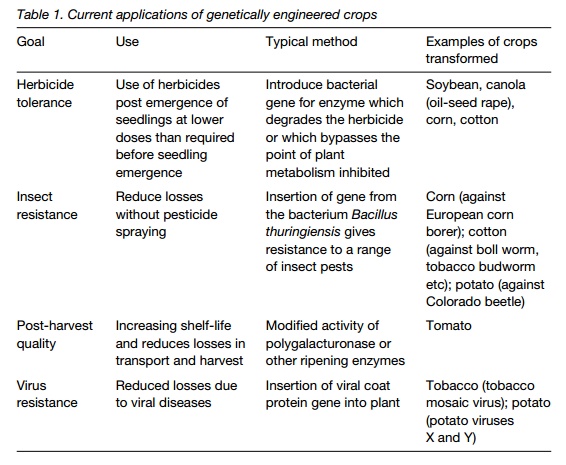Chapter: Plant Biology : Plant genetic engineering and biotechnology
Plant genetic engineering

PLANT GENETIC ENGINEERING
Key Notes
The concept
Genetic manipulation involves inserting foreign genes or modifying the activity of existing genes. Methods to insert foreign genes are coupled with the methods of plant tissue culture to regenerate identical populations of plants with novel characteristics.
Basic genetic manipulation methods
Agrobacterium tumifaciens is a soil bacterium with a plasmid that inserts foreign DNA into a plant. The plasmid contains a T-DNA transferred into the plant and a VIR region that facilitates transfer of the T-DNA.
Binary vectors for genetic engineering consist of one plasmid containing the VIR region and a second containing the T-DNA including the foreign DNA. Where the Agrobacterium system cannot be used, direct gene transfer techniques may be employed, for instance using a DNA particle gun.
Possibilities of genetic manipulation
The aims of genetic manipulation are to enhance agriculture by modifying crop plants, to minimize inputs and losses, and maximize yields and value. To date, crops have been engineered for herbicide tolerance, insect and virus resistance and post-harvest quality. In the future, a much broader spectrum of improvements of wider benefit is proposed.
Risks of genetic Manipulation
Risks identified include: environmental, such as cross pollination and gene transfer with native species; food safety, mainly the transfer of antibiotic resistance to bacteria, allergies and toxicity; and socioeconomic, food supply in the hands of few multinational companies.
The concept
Genetic engineering (recombinant DNA technology) involves inserting foreign genes or modifying the activity of existing genes. A soil bacterium,Agrobacterium tumifaciens, naturally inserts its own bacterial genes into plant genomes. The result is a crown gall, a swelling of the stem at soil level caused by over-production of auxins, and cytokinins produced by enzymes encoded by genes transferred from the bacterial genome. The regeneration of entire plants from single cells or explants has been carried out for many decades to produce clonal populations of plants. Together, the two provide genetic engineers the tools for the insertion of genes from another organism into a plant and the regeneration of a clonal population of that plant. All the members of that population will express the foreign gene.


Basic genetic manipulation methods
Agrobacterium tumifaciens contains a plasmid, a circular piece of DNA separate from the bacterial chromosome, known as the Ti plasmid (Fig. 1). This plasmid contains genes which will be randomly inserted into the plant genome (transferred or T-DNA) and genes involved in the transfer of the DNA (the VIR or virulenceregion for infection). Normally, the T-DNA region contains genes for auxin and cytokinin biosynthesis and for amino acid and sugar derivative production. For genetic manipulation, the Ti plasmid is modified by the removal of the genes within the T DNA region using restriction enzymes that cut DNA at specific nucleotide sequences. The action of the restriction enzymes leaves a linear strand of DNA with ‘sticky’ ends where the nucleotides are unpaired and therefore able to join to a complementary nucleotide sequence in another strand of DNA.
A gene of interest in another organism (animal, plant or bacterium) is identified and prepared for insertion into the Ti plasmid. It is cut out of its host with the same restriction enzymes used to prepare the Ti plasmid, again leaving sticky ends. This cut DNA is then mixed with the modified plasmid DNA, the two DNA strands join at their sticky ends and are sealed together by the enzyme, DNA ligase, to form a recombinant plasmid (Fig. 2). The gene inserted must contain a promoter which will allow it to be expressed in the plant.
Frequently, a second gene will also be inserted into the plasmid, in addition to the gene of interest. This is a selectable marker gene that will give the plant antibiotic resistance or herbicide tolerance. This gene will have also been cloned from another organism, usually a bacterium. Any plant material now expressing these genes will show the properties the marker gene confers, herbicide tolerance or antibiotic resistance, and will grow in media containing either the herbicide or antibiotic while non-transformed material cannot. In this way they can be used to select transformed plants from non-transformed ones.
Plant material (callus; leaf discs, suspension cultures or organs) is then infected by incubating the cells with Agrobacterium containing the plasmid and grown on agar plates containing antibiotic. Only material containing the gene of interest together with the antibiotic resistance marker then grows. Clonal populations of transformed plants can then be produced by micropropagation (Fig. 3;).
Commonly, a binary vector system (Fig. 1) is used to transform plants. This system has the VIR region in a Ti plasmid modified by the removal of the T-DNA, while the T-DNA is in a second Ti plasmid. The plant is then transformed using the engineered Agrobacterium containing both plasmids, one including the VIR region and the other the T-DNA.

Some species cannot be transformed easily using A. tumifaciens. However, DNA constructs can be introduced into plant tissue directly using a DNA particle gun (Fig. 3). DNA is coated onto tungsten particles and fired at the specimen. The projectile is stopped by a barrier with a fine hole through which the tungsten particles carrying DNA can travel at high speed. They then penetrate the cell and some of the DNA enters the nucleus, causing transformation.


Possibilities of genetic manipulation
Production of genetically engineered crops has begun on a large scale. Table 1 presents examples of uses of the technology, while Table 2 presents some futureprospects. The ability to transfer one or two genes into a genome has greatpotential in many areas of agriculture, for instance to reduce losses from pestsand disease. Each situation requires a separate strategy to engineer a successfulcrop; Table 1 presents some examples. Achieving the goals listed in Table 2 maybe more difficult, as some of the characteristics require the insertion or modification of more than one gene. As genes are inserted randomly into the genome by Agrobacterium, each transformant must be assessed separately for the consequences of transformation.

Risks of genetic manipulation
The risks of plant genetic manipulation may be divided into three classes: environmental, food safety and socio-economic. Environmental risks include (i) cross pollination of genetically modified (GM) crops with native species and (ii) damage to fauna, e.g. to insect populations or natural predators. Food safety risks include the transfer of antibiotic resistance marker genes into other organisms, e.g. bacteria that may enter the human food chain. Some fear potential but as yet unproven long-term health risks from consuming GM materials. Socioeconomic risks concern the fact that GM crops are patented and largely in the hands of a few multinational companies; that GM permits seed suppliers to have much greater control over the livelihood of agriculturalists, particularly in less developed nations; and that GM technology may benefit the rich at the
expense of the poor. Against these arguments are the needs of a world population increasing by 1 billion approximately every 12 years, the rigorous testing of GM products and the potentially damaging effects of many current agricultural practices. Plant genetic modification is likely to remain controversial for some time as, in many parts of the world, considerable public opinion is against it.
Related Topics